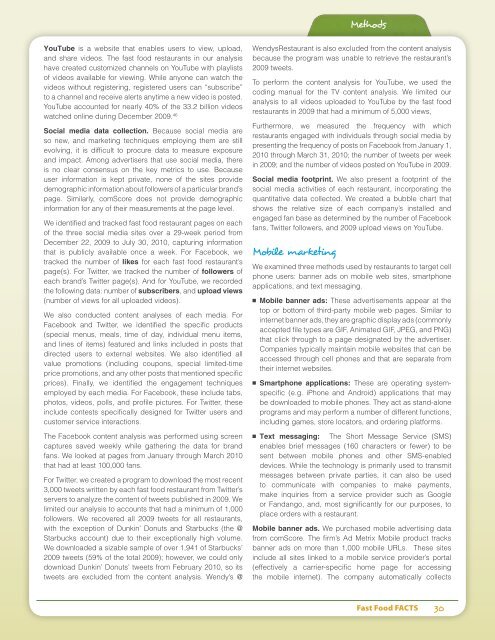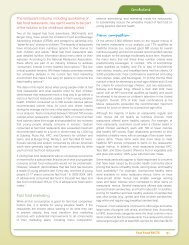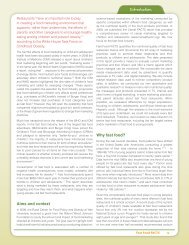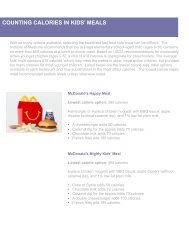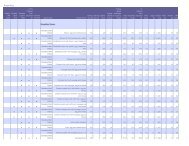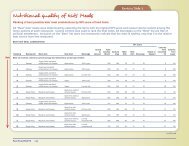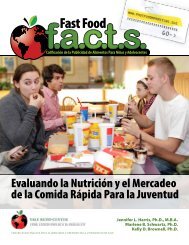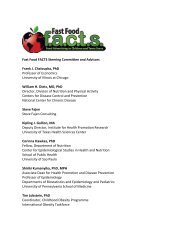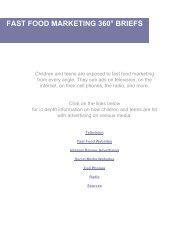Methods Fast food menus and nutritional quality - Fast Food FACTS
Methods Fast food menus and nutritional quality - Fast Food FACTS
Methods Fast food menus and nutritional quality - Fast Food FACTS
You also want an ePaper? Increase the reach of your titles
YUMPU automatically turns print PDFs into web optimized ePapers that Google loves.
YouTube is a website that enables users to view, upload,<br />
<strong>and</strong> share videos. The fast <strong>food</strong> restaurants in our analysis<br />
have created customized channels on YouTube with playlists<br />
of videos available for viewing. While anyone can watch the<br />
videos without registering, registered users can “subscribe”<br />
to a channel <strong>and</strong> receive alerts anytime a new video is posted.<br />
YouTube accounted for nearly 40% of the 33.2 billion videos<br />
watched online during December 2009. 46<br />
Social media data collection. Because social media are<br />
so new, <strong>and</strong> marketing techniques employing them are still<br />
evolving, it is difficult to procure data to measure exposure<br />
<strong>and</strong> impact. Among advertisers that use social media, there<br />
is no clear consensus on the key metrics to use. Because<br />
user information is kept private, none of the sites provide<br />
demographic information about followers of a particular br<strong>and</strong>’s<br />
page. Similarly, comScore does not provide demographic<br />
information for any of their measurements at the page level.<br />
We identified <strong>and</strong> tracked fast <strong>food</strong> restaurant pages on each<br />
of the three social media sites over a 29-week period from<br />
December 22, 2009 to July 30, 2010, capturing information<br />
that is publicly available once a week. For Facebook, we<br />
tracked the number of likes for each fast <strong>food</strong> restaurant’s<br />
page(s). For Twitter, we tracked the number of followers of<br />
each br<strong>and</strong>’s Twitter page(s). And for YouTube, we recorded<br />
the following data: number of subscribers, <strong>and</strong> upload views<br />
(number of views for all uploaded videos).<br />
We also conducted content analyses of each media. For<br />
Facebook <strong>and</strong> Twitter, we identified the specific products<br />
(special <strong>menus</strong>, meals, time of day, individual menu items,<br />
<strong>and</strong> lines of items) featured <strong>and</strong> links included in posts that<br />
directed users to external websites. We also identified all<br />
value promotions (including coupons, special limited-time<br />
price promotions, <strong>and</strong> any other posts that mentioned specific<br />
prices). Finally, we identified the engagement techniques<br />
employed by each media. For Facebook, these include tabs,<br />
photos, videos, polls, <strong>and</strong> profile pictures. For Twitter, these<br />
include contests specifically designed for Twitter users <strong>and</strong><br />
customer service interactions.<br />
The Facebook content analysis was performed using screen<br />
captures saved weekly while gathering the data for br<strong>and</strong><br />
fans. We looked at pages from January through March 2010<br />
that had at least 100,000 fans.<br />
For Twitter, we created a program to download the most recent<br />
3,000 tweets written by each fast <strong>food</strong> restaurant from Twitter’s<br />
servers to analyze the content of tweets published in 2009. We<br />
limited our analysis to accounts that had a minimum of 1,000<br />
followers. We recovered all 2009 tweets for all restaurants,<br />
with the exception of Dunkin’ Donuts <strong>and</strong> Starbucks (the @<br />
Starbucks account) due to their exceptionally high volume.<br />
We downloaded a sizable sample of over 1,941 of Starbucks’<br />
2009 tweets (59% of the total 2009); however, we could only<br />
download Dunkin’ Donuts’ tweets from February 2010, so its<br />
tweets are excluded from the content analysis. Wendy’s @<br />
WendysRestaurant is also excluded from the content analysis<br />
because the program was unable to retrieve the restaurant’s<br />
2009 tweets.<br />
To perform the content analysis for YouTube, we used the<br />
coding manual for the TV content analysis. We limited our<br />
analysis to all videos uploaded to YouTube by the fast <strong>food</strong><br />
restaurants in 2009 that had a minimum of 5,000 views,<br />
Furthermore, we measured the frequency with which<br />
restaurants engaged with individuals through social media by<br />
presenting the frequency of posts on Facebook from January 1,<br />
2010 through March 31, 2010; the number of tweets per week<br />
in 2009; <strong>and</strong> the number of videos posted on YouTube in 2009.<br />
Social media footprint. We also present a footprint of the<br />
social media activities of each restaurant, incorporating the<br />
quantitative data collected. We created a bubble chart that<br />
shows the relative size of each company’s installed <strong>and</strong><br />
engaged fan base as determined by the number of Facebook<br />
fans, Twitter followers, <strong>and</strong> 2009 upload views on YouTube.<br />
Mobile marketing<br />
<strong>Methods</strong><br />
We examined three methods used by restaurants to target cell<br />
phone users: banner ads on mobile web sites, smartphone<br />
applications, <strong>and</strong> text messaging.<br />
■ Mobile banner ads: These advertisements appear at the<br />
top or bottom of third-party mobile web pages. Similar to<br />
internet banner ads, they are graphic display ads (commonly<br />
accepted file types are GIF, Animated GIF, JPEG, <strong>and</strong> PNG)<br />
that click through to a page designated by the advertiser.<br />
Companies typically maintain mobile websites that can be<br />
accessed through cell phones <strong>and</strong> that are separate from<br />
their internet websites.<br />
■ Smartphone applications: These are operating systemspecific<br />
(e.g. iPhone <strong>and</strong> Android) applications that may<br />
be downloaded to mobile phones. They act as st<strong>and</strong>-alone<br />
programs <strong>and</strong> may perform a number of different functions,<br />
including games, store locators, <strong>and</strong> ordering platforms.<br />
■ Text messaging: The Short Message Service (SMS)<br />
enables brief messages (160 characters or fewer) to be<br />
sent between mobile phones <strong>and</strong> other SMS-enabled<br />
devices. While the technology is primarily used to transmit<br />
messages between private parties, it can also be used<br />
to communicate with companies to make payments,<br />
make inquiries from a service provider such as Google<br />
or F<strong>and</strong>ango, <strong>and</strong>, most significantly for our purposes, to<br />
place orders with a restaurant.<br />
Mobile banner ads. We purchased mobile advertising data<br />
from comScore. The firm’s Ad Metrix Mobile product tracks<br />
banner ads on more than 1,000 mobile URLs. These sites<br />
include all sites linked to a mobile service provider’s portal<br />
(effectively a carrier-specific home page for accessing<br />
the mobile internet). The company automatically collects<br />
<strong>Fast</strong> <strong>Food</strong> <strong>FACTS</strong> 30


